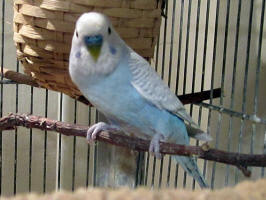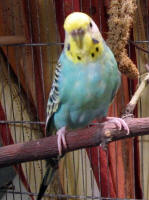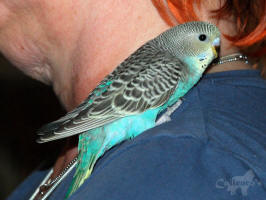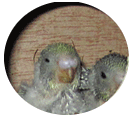The eggs will take about 18–20 days before they start hatching. The
hatchlings are
altricial – blind, naked, totally helpless, and their mother feeds
them and keeps them warm around the clock day and night. Around 10 days
of age, the chicks' eyes will open, and they will start to develop
feather down. The appearance of down occurs precisely at the ages (around
9 or 10 days of age) for closed banding of the chicks.
They develop
feathers
around 3 weeks of age and one can often easily note the colour mutation of
the individual birds at this point. At this stage of the chicks'
development, the male usually has begun to enter the nest to help his
female in caring and feeding the chicks. Some budgerigar females,
however, totally forbid the male from entering the nest and thus take
the full responsibility of rearing the chicks until they fledge.
As the chicks develop and grow feathers, they are able to be left on
their own for longer and longer periods of time. By the fifth week, the
chicks are strong enough that both parents will be comfortable in
staying more and more out of the nest. The youngsters will stretch their
wings to gain strength before they attempt to
fly.
They will also help defend the box from enemies mostly with their loud
screeching. Young budgerigars typically fledge (leave the nest) around
their fifth week of age and are usually completely weaned a week later.
However, the age for fledging as well as weaning can vary slightly
depending on whether it is the oldest, the youngest and/or the only
surviving chick. Generally speaking, the oldest chick is the first to be
weaned. But even though it is logically the last one to be weaned, the
youngest chick is often weaned at a younger age than its older sibling(s).
This can be a result of mimicking the actions of older siblings.
Healthy budgies spend time each day preening themselves so their
feathers are ordered and smooth. Budgies love whistling and chirping, it
can show that your budgie is happy and healthy. Budgies are very social animals and love to communicate, and that
doesn’t stop when you bring them into your house!









